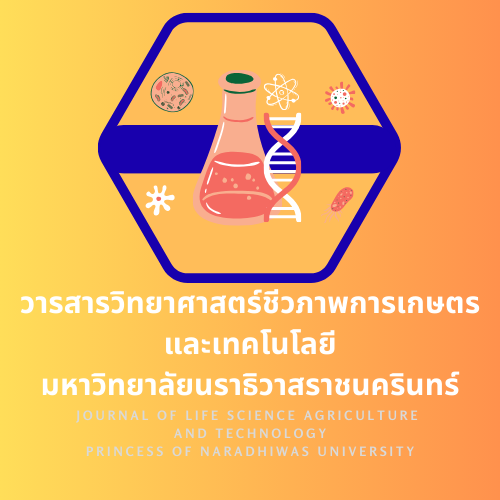การศึกษาปฏิกิริยาเร่งเชิงแสงของอนุภาคนาโนซิงค์ออกไซด์และซิลเวอร์/ซิงค์ออกไซด์ ที่สังเคราะห์ผ่านเคมีสีเขียวโดยใช้สารสกัดใบฝรั่ง
คำสำคัญ:
สารสกัดใบฝรั่ง, อนุภาคนาโนซิลเวอร์/ซิงค์ออกไซด์, ปฏิกิริยาเร่งเชิงแสงบทคัดย่อ
งานวิจัยนี้มีวัตถุประสงค์เพื่อศึกษาปฏิกิริยาเร่งเชิงแสงของอนุภาคนาโนซิงค์ออกไซด์และซิลเวอร์/ซิงค์ ออกไซด์ที่สังเคราะห์ตามหลักเคมีสีเขียวโดยใช้สารสกัดใบฝรั่ง ศึกษาองค์ประกอบของสารสกัดใบฝรั่งโดยใช้เทคนิคฟูเรียร์ทรานส์ฟอร์มอินฟราเรดสเปกโตรสโคปี (FTIR) พบว่ามีองค์ประกอบของหมู่ไฮดรอกซิล (-OH) และหมู่คาร์บอนิล (-C=O) ซึ่งเป็นหมู่ฟังก์ชันของสารประกอบฟินอลิกที่ทำหน้าที่เป็นตัวรีดิวซ์ในการสังเคราะห์อนุภาคนาโนซิงค์ออกไซด์ มีค่าช่องว่างพลังงานของซิงค์ออกไซด์ 3.30 อิเล็กตรอนโวลต์ และค่าช่องว่างพลังงานของอนุภาคนาโนซิลเวอร์/ซิงค์ออกไซด์ 3.33 อิเล็กตรอนโวล ซึ่งแสดงให้เห็นว่าการเจืออนุภาคซิลเวอร์บนพื้นผิวซิงค์ ออกไซด์ส่งผลให้ช่องว่างพลังงานสูงขึ้นและอนุภาคที่สังเคราะห์มีขนาดในระดับนาเมตรด้วย จากนั้นศึกษาปฏิกิริยาเร่งเชิงแสงของอนุภาคนาโนซิงค์ออกไซด์และซิลเวอร์/ซิงค์ออกไซด์ผ่านการสลายสีย้อมโรดามีน บี ภายใต้แสงยูวี เป็นเวลา 150 นาที แล้วนำไปวัดค่าการดูดกลืนแสงที่ความยาวคลื่นสูงสุดของสีย้อมโรดามีน บี คือ 554 นาโนเมตร พบว่าซิงค์ออกไซด์เผาที่อุณหภูมิ 400 องศาเซลเซียส มีร้อยละการสลายสีย้อมต่ำสุดคือร้อยละ 24.36 และเมื่อเพิ่มอุณหภูมิในการเผาเป็น 900 องศาเซลเซียส มีร้อยละการสลายสีย้อมสูงขึ้นเป็นร้อยละ 49.45 ซึ่งสอดคล้องกับผลสเปกตรัมที่แสดงแถบการสั่นของ Zn-O เข้มขึ้น เนื่องจากเมื่อเพิ่มอุณหภูมิในการเผาความเป็นผลึกของซิงค์ออกไซด์สูงขึ้น เมื่อนำซิงค์ออกไซด์หลังเผามาเจือด้วยซิลเวอร์โดยวิธีโฟโตรีดักชัน พบว่าส่งผลให้ ภาพในการสลายสีย้อมสูงขึ้นอย่างเห็นได้ชัด โดยซิลเวอร์/ซิงค์ออกไซด์เผาที่อุณหภูมิ 400 องศาเซลเซียส มีการสลายสีย้อมร้อยละ 87.99 และซิลเวอร์/ซิงค์ออกไซด์เผาที่อุณหภูมิ 900 องศาเซลเซียส มีการสลายสีย้อมสูงสุดคือร้อยละ 97.90 ซึ่งแสดงถึงอิทธิพลจากการเผาร่วมกับการเจือซิลเวอร์บนพื้นผิวของซิงค์ออกไซด์ที่ทำให้ปฏิกิริยาเร่งเชิงแสงมีประสิทธิภาพสูง
เอกสารอ้างอิง
Abu, B. F., & Mohd, S. I. (2023). Synthesis of TiO2 photocatalyst with tunable optical properties and exposed facet for textile wastewater treatment. Results in Optics, 13, 100545.
Changan, S. S., Prajapat, R., Kumar, M., Saurabh, V., Sindhu, N., Shukla, P., & Amarowicz, R. (2021). Guava (Psidium guajava L.) Leaves: Nutritional Composition, Phytochemical Profile, and Health-Promoting Bioactivities. Foods, 10(4), 752.
Elias, M., Uddin, M. N., Saha, J. K., Hossain, M. A., Sarker, D. R., Akter, S., Siddiquey, I. A., & Uddin, J. (2021). A highly efficient and stable photocatalyst; N-doped ZnO/CNT composite thin film synthesized via simple sol-gel drop coating method. Molecules, 26(5), 1470.
Etcheverry, L. P., Flores, W. H., da Silva, D. L., & Moreira, E. C. (2018). Annealing Effects on the
Structural and Optical Properties of ZnO Nanostructures. Materials Research, 21(2).
Herzi, A., Sebais, M., Boudine, B., & Guerbous, L. (2019). Fabrication and Characterization of Highly Textured Thin Films of Undoped and Ag-Doped ZnO. Journal of Materials Science: Materials in Electronics, 30(7), 7008–7015.
Hussain, A., Fiaz, S., Almohammedi, A., & Waqar, A. (2024). Optimizing photocatalytic
performance with Ag-doped ZnO nanoparticles: Synthesis and characterization. Heliyon, 10, e35725.
Jeyasundari, J., Praba, P. S., Jacob, Y. B. A., Vasantha, V. S., & Shanmugaiah, V. (2017). Green Synthesis and Characterization of Zero Valent Iron Nanoparticles from the Leaf Extract of Psidium guajava Plant and Their Antibacterial Activity. Chemical Science Review and Letters, 6(22), 1244–1252.
Kadhem, A. A., & Alshamsi, H. A. (2023). Biosynthesis of Ag-ZnO/rGO nanocomposites mediated Ceratophyllum demersum L. leaf extract for photocatalytic degradation of Rhodamine B under visible light. Biomass Conversion and Biorefinery. Advance online publication.
Kaningini, M. M., Azizi, S., & Mokrani, T. (2022). Effect of Optimized Precursor Concentration, Temperature, and Doping on Optical Properties of ZnO Nanoparticles Synthesized via a Green Route Using Bush Tea (Athrixia phylicoides DC.) Leaf Extracts. ACS Omega, 7(9), 7856–7865.
Kumar, M., Kumar, S., & Singh, R. (2015). Fabrication and properties of zinc oxide thin film prepared by sol-gel dip coating method. Materials Science-Poland, 33(2), 297–302.
Mirzaeifard, Z., Shariatinia, Z., Jourshabani, M., & Rezaei, S. M. (2020). ZnO Photocatalyst revisited: Effective photocatalytic degradation of emerging contaminants using S-doped ZnO nanoparticles under visible light radiation. Industrial & Engineering Chemistry Research, 59(36), 15894–15911.
Nagaraju, G., Udayabhan, A., Shivaraj, A., Prashanth, S. A., Shastri, M., Yathish, K. V., Anupama, C., & Rangappa, D. (2017). Electrochemical heavy metal detection, photocatalytic, photoluminescence, biodiesel production and antibacterial activities of Ag–ZnO nanomaterial. Materials Research Bulletin, 94, 54–63.
Noohpisheh, Z., Amiri, H., Farhadi, S., & Zaringhadam, P. (2020). Green synthesis of Ag-ZnO nanocomposites using Trigonella foenum-graecum leaf extract and their antibacterial, antifungal, antioxidant and photocatalytic properties. Spectrochimica Acta Part A: Molecular and Biomolecular Spectroscopy, 240, 118595.
Ochieng, P. E., Iwuoha, E., Michira, I., Masikini, M., Ondiek, J., Githira, P., & Kamau, G. N. (2015). Green Route Synthesis and Characterization of ZnO Nanoparticles Using Spathodea campanulata. International Journal of BioChemiPhysics, 23, 53–61.
Patil, S. P., & Rane, P. M. (2020). Psidium guajava leaves assisted green synthesis of metallic nanoparticles: A review. Beni-Suef University Journal of Basic and Applied Sciences, 9 (1), 60.
Raza, W., Ahmad, K., Khan, R. A. & Kim, H. (2023). Ag decorated ZnO for enhanced photocatalytic H2 generation and pollutant degradation. International Journal of Hydrogen Energy, 48(75), 29071–29081.
Shameli, K., Bin Ahmad, M., Zamanian, A., Sangpour, P., Shabanzadeh, P., & Abdollahi, Y. (2017). Biosynthesis of Ag, ZnO and bimetallic Ag/ZnO alloy nanoparticles by aqueous extract of oak fruit hull (Jaft) and investigation of photocatalytic activity of ZnO and bimetallic Ag/ZnO for degradation of basic violet 16. Journal of Materials Science: Materials in Electronics, 28(36), 1–12.
Sougandhi, P. R., & Ramanaiah, S. (2020). Green synthesis and spectral characterization of silver nanoparticles from Psidium guajava leaf extract. Inorganic and Nano-Metal Chemistry, 50(12), 1290–1294.
Vittaya, L., & Chalad, C. (2022). Synthesis and characterization of zinc oxide nanoparticles with the rhizome extract of Ampelocissus martini to inhibit pathogenic bacteria. Rajamangala University of Technology Srivijaya.
Zhang, D., Lv, S., and Luo, Z. (2020). A study on the photocatalytic degradation performance of a [KNbO3]0.9-[BaNi0.5Nb0.5O3−δ] 0.1 perovskite. RSC Advances, 10(3), 1275–1280.
Zhang, X., Zhang, L., Xie, T., & Wang, D. (2015). Fabrication of porous 3D flower-like Ag/ZnO heterostructure composites with enhanced photocatalytic performance. Journal of Materials Chemistry A, 3(1), 1234–1242.
Zhang, X., Zhang, P., & Su, H. (2016). Synthesis and characterization of Ag–ZnO heterostructure for enhanced photocatalytic performance. Applied Surface Science, 387, 216–222.
ดาวน์โหลด
เผยแพร่แล้ว
รูปแบบการอ้างอิง
ฉบับ
ประเภทบทความ
สัญญาอนุญาต
ลิขสิทธิ์ (c) 2025 วารสารวิทยาศาสตร์ เกษตรและเทคโนโลยี

อนุญาตภายใต้เงื่อนไข Creative Commons Attribution-NonCommercial-NoDerivatives 4.0 International License.
ข้อความลิขสิทธิ์ เติมด้วยค่ะ





